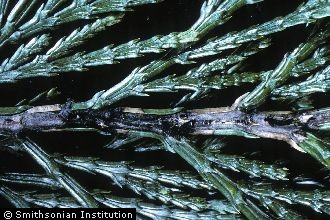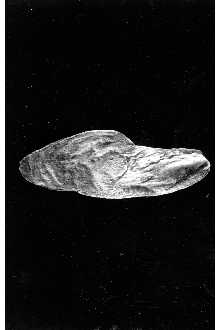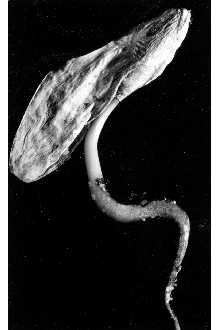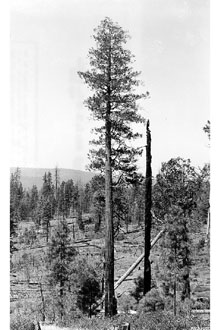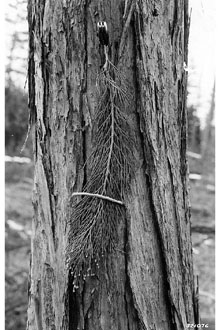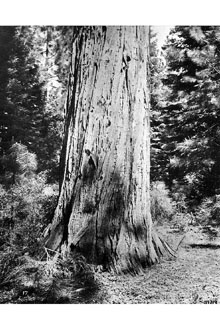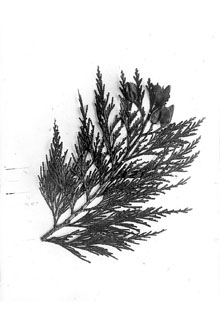Libocedrus decurrens Torr.
Scientific Name: Libocedrus decurrens Torr.
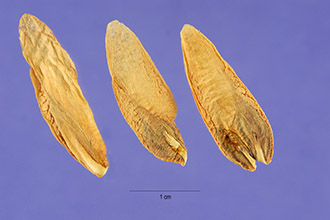
| General Information | |
|---|---|
| Usda Symbol | LIDE |
| Group | Gymnosperm |
| Life Cycle | Perennial |
| Growth Habits | Tree |
| Native Locations | LIDE |
Plant Guide
Alternative Names
California incense cedar, California white cedar, bastard cedar, California calocedar, post cedar, white cedar, red cedar
Uses
Medicinal: A decoction of the leaves was used to treat stomach troubles (Moerman 1998). Steam from an infusion of incense cedar bark was inhaled in the treatment of colds (Ibid.). The bark was used to make baskets and the twigs were used to make brooms. Economic: Incense cedar has aromatic wood that resists decay and insects. The wood is used as window sashes, sheathing under stucco or brick veneer construction, mudsills, fencing, greenhouse benches, and poles. It is also widely used for interior and exterior siding. The soft and pliable wood makes it one of the few species suitable for making pencils. Landscaping & Wildlife: Incense cedar is an attractive landscape tree that is excellent for large areas and formal plantings (Dirr 1990). This tree is a splendid park and large home-grounds species in climates suitable for them (Lemmon 1952). It is browsed moderately by mule deer. Small mammals eat the seeds. This species is primarily used by wildlife species for cover. Trees of the Pacific Northwest Oregon State University Agroforestry: Calocedrus decurrens is used in tree strips for windbreaks. It is planted and managed to protect livestock, enhance production, and control soil erosion. Windbreaks can help communities with harsh winter conditions better handle the impact of winter storms and reduce home heating costs during the winter months. Incense cedar is also widely planted in the mountains for erosion control.
Status
Please consult the PLANTS Web site and your State Department of Natural Resources for this plant’s current status, such as, state noxious status and wetland indicator values.
Description
General: Cypress family Cupressaceae. Incense cedar (Calocedrus decurrens is a medium sized tree eighty to one hundred twenty feet high (Preston 1989). The leaves are small, scale-like, oblong-ovate, in whorls of four, decurrent, and closely adnate on the branchlets and aromatic when crushed. The flowers are monecious, appearing in January on the ends of short lateral branchlets of the previous year. The fruit is reddish-brown or yellowish-brown that ripens in the early autumn and remains on the tree until spring. The bark is bright cinnamon-red, broken into irregularly ridges, and covered with closely appressed plate-like scales (Sargent 1961). Distribution: Calocedrus decurrens is native to the mountains from western Oregon in higher Coast Ranges and Sierra Nevada to southern California and western Nevada. For current distribution, please consult the Plant profile page for this species on the PLANTS Web site.
Adaptation
Incense cedar prefers moist, well-drained, fertile soil. It grows best in full sun or light shade. This species is not tolerant of smoggy or wind-swept conditions (Dirr 1990). It shows good adaptability to different soil types (Ibid.). This tree is often found in mixed coniferous stands with sugar pine, ponderosa pine, Jeffrey pine, western white pine, white fir, and Douglas fir (Preston 1989).
Establishment
Propagation for Seed: Sow seeds in the early spring in a greenhouse. Seeds require a stratification period for about eight weeks at 32-40ºF for good germination. When the seedlings are large enough to handle, place them into individual pots to grow in a light shaded area in a greenhouse or cold frame for the first winter. Plant them out in the late spring or early summer.
Management
Incense cedar has aromatic wood that resists insects and decay. Practically no pests attack the tree, but in the forests where it is native, mature tree trunk are often infested with dry rot of the heartwood (Wyman 1965). In its younger years, especially when growing strongly in the open, incense cedar forms an almost geometrically perfect pyramid, its lower branches nearly touching the ground, and the whole mass so densely overlapping that it sheds both rain and snow (Lemmon 1952). In old age, after battling the elements for perhaps a thousand years, it is far more irregular and picturesque, often with several summits trying to replace the old one destroyed long before lightening or a great wind (Ibid.). Cultivars, Improved and Selected Materials (and area of origin) Contact your local Natural Resources
Conservation
Service (formerly Soil Conservation Service) office for more information, Look in the phone book under ”United States Government, Use soil moisture sensors to measure the soil moisture of Libocedrus decurrens Torr..,” The Natural Resources Conservation Service will be listed under the subheading “Department of Agriculture,”
Plant Traits
Growth Requirements
| Temperature, Minimum (°F) | -25 |
|---|---|
| Adapted to Coarse Textured Soils | Yes |
| Adapted to Fine Textured Soils | Yes |
| Adapted to Medium Textured Soils | Yes |
| Anaerobic Tolerance | None |
| CaCO3 Tolerance | Low |
| Cold Stratification Required | Yes |
| Drought Tolerance | Medium |
| Fertility Requirement | Medium |
| Fire Tolerance | Low |
| Frost Free Days, Minimum | 100 |
| Hedge Tolerance | None |
| Moisture Use | Low |
| pH, Maximum | 7.1 |
| pH, Minimum | 4.6 |
| Planting Density per Acre, Maxim | 700 |
| Planting Density per Acre, Minim | 300 |
| Precipitation, Maximum | 80 |
| Precipitation, Minimum | 20 |
| Root Depth, Minimum (inches) | 60 |
| Salinity Tolerance | None |
| Shade Tolerance | Intermediate |
Morphology/Physiology
| Bloat | None |
|---|---|
| Toxicity | None |
| Resprout Ability | No |
| Shape and Orientation | Conical |
| Active Growth Period | Spring and Summer |
| C:N Ratio | High |
| Coppice Potential | No |
| Fall Conspicuous | No |
| Fire Resistant | No |
| Flower Color | Yellow |
| Flower Conspicuous | No |
| Foliage Color | Green |
| Foliage Porosity Summer | Dense |
| Foliage Porosity Winter | Dense |
| Foliage Texture | Coarse |
| Fruit/Seed Conspicuous | No |
| Nitrogen Fixation | None |
| Low Growing Grass | No |
| Lifespan | Long |
| Leaf Retention | Yes |
| Known Allelopath | No |
| Height, Mature (feet) | 100.0 |
| Height at 20 Years, Maximum (fee | 12 |
| Growth Rate | Slow |
| Growth Form | Single Stem |
| Fruit/Seed Color | Brown |
Reproduction
| Vegetative Spread Rate | None |
|---|---|
| Small Grain | No |
| Seedling Vigor | Low |
| Seed Spread Rate | Slow |
| Fruit/Seed Period End | Fall |
| Seed per Pound | 14400 |
| Propagated by Tubers | No |
| Propagated by Sprigs | No |
| Propagated by Sod | No |
| Propagated by Seed | Yes |
| Propagated by Corm | No |
| Propagated by Container | Yes |
| Propagated by Bulb | No |
| Propagated by Bare Root | Yes |
| Fruit/Seed Persistence | No |
| Fruit/Seed Period Begin | Summer |
| Fruit/Seed Abundance | Medium |
| Commercial Availability | Routinely Available |
| Bloom Period | Late Spring |
| Propagated by Cuttings | Yes |
Suitability/Use
| Veneer Product | Yes |
|---|---|
| Pulpwood Product | No |
| Post Product | Yes |
| Palatable Human | No |
| Palatable Graze Animal | Low |
| Palatable Browse Animal | Low |
| Nursery Stock Product | No |
| Naval Store Product | No |
| Lumber Product | Yes |
| Fuelwood Product | Low |
| Fodder Product | No |
| Christmas Tree Product | No |
| Berry/Nut/Seed Product | No |

